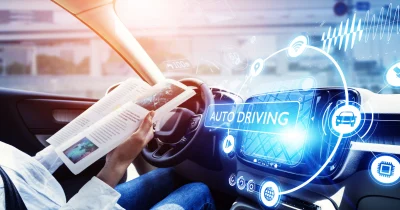Self-driving cars – once a futuristic concept – are becoming a tangible reality. The world has long since moved on from fictional pop culture icons like Herbie, KITT, and Johnny Cab taxis, looking towards a self-driving future based in reality.
The fascination with self-driving cars goes beyond mere day dreams since advancements with autonomous vehicles (AVs) is changing how fleet, freight, and logistics companies operate. How far are we from a fully self-driving future?
What the experts say
Research shows we’re getting there. Venson Automotive Solutions published a white paper this month, titled ‘The Journey Towards Full Driving Automation.’
It explains how driverless cars will transform fleet operations, and how the UK is set to become a world leader in this space.
The intelligent mobility market is worth £900 billion ($1.14 trillion), and the “UK market alone could be worth as much as £42 billion ($53 billion) by 2035.” The research team says this could create as many as 38,000 jobs in the sector.
Luckily, research done by McKinsey Future of Mobility shows that 46% of people are “open to replacing their private vehicles with other modes of transport in the coming decade.” In addition, 70% are “willing to use a shared autonomous shuttle with up to three others.”
Self-driving case studies
Cruise, the autonomous vehicle subsidiary of General Motors (GM), is probably the most well-known case study cited in the white paper. The company saw a giant leap during the first quarter of 2022 when it began offering robo-taxi rides in San Francisco.
The initial Cruise fleet consisted of 30 Chevrolet Bolt EVs limited to a max 30mph. These driverless vehicles were also not allowed to operate on highways or during heavy rain.
After several incidents – such as permits being withdrawn in San Francisco and an accident involving a human-driving vehicle – Cruise is scaling back its aggressive strategy, focusing instead on a single-city approach to regain trust while sharpening its safety features.
ALSO READ: Cruise adjusts course amid layoffs and operational pauses
Then there’s Wayve, a startup that made headlines when Microsoft co-founder Bill Gates blogged about his experience of being driven around London in a self-driving car, with a safety driver.
Gates says while other autonomous driving companies work only on maps, “Wayve’s technology operates more like a human driver – learning how to drive in one city and then applying that knowledge to new places.”
At the time of the trip, Gates credited Wayve CEO Alex Kendall for “picking one of the most difficult situations I’ve seen in an autonomous car. London is a very challenging place to drive. The humans are having a hard time trying to make judgment calls.”
UK Self-driving legislation
During a panel session at the MOVE 2023 urban mobility event, Nicholas Paines from The Law Commission said they would spend the next three years reviewing and updating laws pertaining to self-driving legislation.
They need to determine whether self-driving and automated vehicles can safely and legally be used on Britain’s roads. It’s a landmark move since this is the first time The Law Commission has been tasked to create laws meant to address future technology and situations.
The Law Commissions propose the following changes:
- User-in-charge: An occupant known as the user-in-charge must be in the driver’s seat, and may need to take charge of the vehicle if it encounters any issues.
- Authorized self-driving entity (ASDE): Appointing a person responsible for dealing with legal issues if an automated system causes unlawful driving.
- No user-in-car (NUIC) features: Some vehicles may operate without a user-in-charge, with oversight by a licensed NUIC operator.
- Civil liability: Under the Automated and Electric Vehicles Act 2018, insurers compensate victims directly, without requiring proof of fault.
Companies will only be able to obtain a NUIC license if they are of good repute and in good financial standing, with a base of operations in Great Britain, and with a record of professional competence.
While challenges remain, the benefits and improvements in safety and efficiency that come with autonomous driverless cars cannot be overstated. As AV technology continues to evolve, it will undoubtedly shape the future of transportation and logistics.
About the author
Cheryl has contributed to various international publications, with a fervor for data and technology. She explores the intersection of emerging tech trends with logistics, focusing on how digital innovations are reshaping industries on a global scale. When she's not dissecting the latest developments in AI-driven innovation and digital solutions, Cheryl can be found gaming, kickboxing, or navigating the novel niches of consumer gadgetry.











